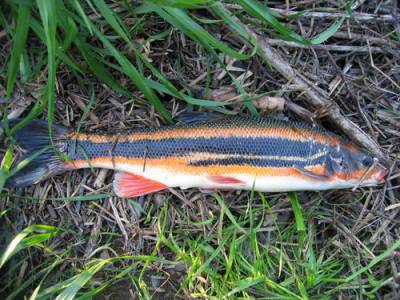Neon tetra,
Paracheirodon innesi, cardinal tetra, Cheirodon
axelrodi, and some other characins, which inhabit optically turbid blackwater
streams and flood lagoons of the Amazon basin, have extremely bright coloration
with lateral blue or blue-green stripes and red rear abdominal area (e.g.,
Lythgoe & Shand, 1983; Ikeda & Kohshima,
2009). It is important that blue stripes are located in these fish on the upper
most illuminated part of their body while the red area is located on the under
shadowed part of the body.
Note also
that coloration of neon tetra does not differ between sexes
or among growth stages.
In order to
understand principles of the foregoing coloration design, we must address to
the spectral sensitivity of eyes in human and fish. Because, generally, the
curves of spectral sensitivity have the bell like form, different equipower
monochromatic colors are not equally bright.
For example,
for eyes of human (as an agreed standard observer), the maximum of spectral
sensitivity is near 555 nm. It means that for our eyes blue-green colors (with
wavelengths, say, 510-520 nm according to the reflection spectrum of blue
stripes in tetra: Lythgoe & Shand, 1983) are brighter than red colors (620-640
nm to the red area). On the contrary, the curve of spectral sensitivity in
tetra is shifted, similarly to other freshwater fish, to the red part of the
spectrum, with the longwave maximum at 607 nm (Lythgoe & Shand, 1983). Thus,
for eyes of tetra red colors must look brighter than blue-green colors as opposed to our visual perception.
In
sum, blue-green stripes that are bright for us must be dim for neon tetra. Hereof
location of blue colors on the upper most illuminated part of the fish’s body (above
the line of body convexity) and red colors on the under shadowed part of the
body are in conformity with the theory of color countershading in fresh waters.
Importantly,
blue-green and near red (near to orange) colors in the reflection spectra of
tetra’s body (Lythgoe
& Shand, 1983) form an exactly matched pair of complementary colors.
Developing these colors, tetras are able to find the trade-off between conspicuousness
(maximising it) for conspecifics (Endler, 1992) and crypticity (minimising
conspicuousness) for potential predators.
Main natural
predators for neon tetras are butterfly peacock, Cichla ocellaris, red-finned pike cichlid, Crenicichla johanna, and leaf fish, Monocirrhus polyacanthus, which eat tetras without any signs of
avoidance (Ikeda & Kohshima, 2009). Nothing is known
about spectral sensitivity of these predatory fish. However, in waters
saturated with the litter organics, where C.
ocellaris, C. johanna and M. polyacanthus live, the curves of
their spectral sensitivity must have red displacement, by definition. On the
other hand, C. ocellaris and C. johanna are ecologically close to
largemouth bass, Micropterus salmoides, with
the maximum of spectral sensitivity at 673 nm (Kawamura & Kishimoto, 2002). Comparison of these cichlids with
cichlids from optically clean African lakes is incorrect. In Florida’s eutrophic optically turbid channels,
introduced C. ocellaris and native M.
salmoides are forced to co-exist, hunt practically the same prey (Fill et
al., 2004), and there are no doubts that their eyes have similar
spectral sensitivities.
For
information, eyes of piranchas, Serrasalmus
sp., and other predatory characins have well developed long wavelength
sensitive visual pigments in the range of 600-630 nm (Kusmic & Gualtieri, 2000).
Similar patterns,
with the upper location of blue colors and the under location of red colors,
occur in many other freshwater fish. For example, breeding males of threespined
stickleback, Gasterosteus aculeatus,
have blue eyes and red breast. The maximum of spectral sensitivity in
stickleback is near 605 nm (Rowe et al., 2004). The same value in pike, Esox lucius, their natural predators, is 630 nm (Protasov, 1968). In the similar way, bluegill, Lepomis macrochirus, have blue gill
covers and orange belly. The maximum of spectral sensitivity in sunfish is near
612 nm (Tamura
& Niwa, 1967). The same value in largemouth bass, their natural predators, is 673 nm,
as metioned above. So blue colors are brighter, that is signaling, for their
owners and much more darker, that is cryptic, for co-existent predatory fish.
Pecos
...
Read more »




